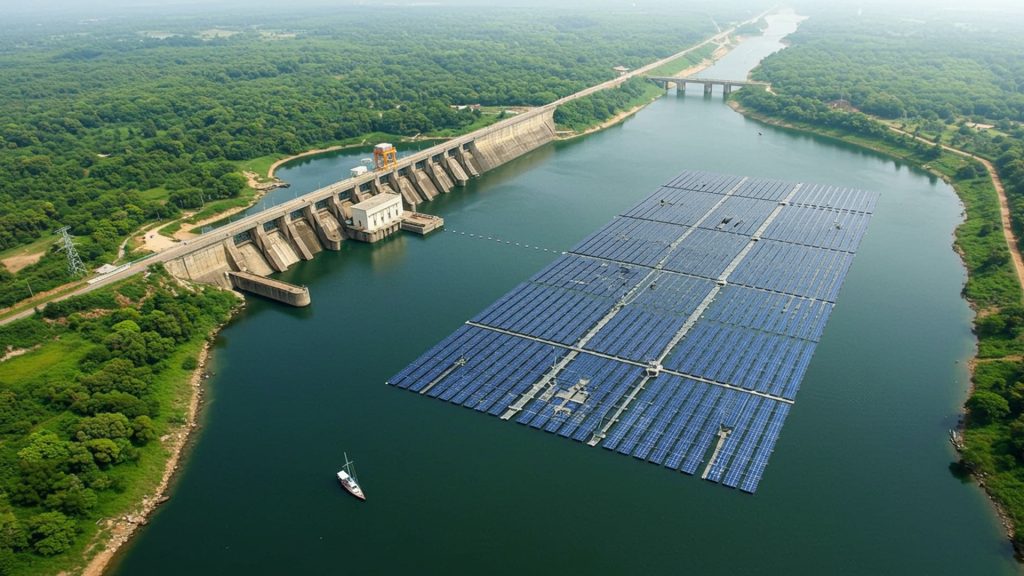Maharashtra has officially approved its landmark hybrid power project, marking a major step towards cleaner energy for the state. This pioneering project combines solar and wind power, setting a new standard for renewable energy plans across India. The decision, made this week, helps Maharashtra move closer to its goal of greatly increasing its green power supply. This new energy source will bring stable, clean electricity to homes and businesses, reducing reliance on older power methods and shaping the future of power production in the region.
Major Project Receives Key Approval
The state government in Maharashtra has given its final nod for a essential new hybrid power project. This project is set to be built at the Middle Vaitarna Dam. The approval involves allowing the use of 4. 90 hectares of reserved forest land for the project. This was a crucial step. with this clearance, work can now begin on building this power plant.
The new power project will be quite large, with a total capacity of 100 megawatts (MW). It is a hybrid type, meaning it will use two different sources to make electricity. Specifically, it will combine 20 MW of power from water (hydroelectric) and 80 MW from floating solar panels. The dam is located in Kochale village, which is in the Mokhada area of Palghar district.
This project is special because it is the first time a city body in India is going for a big hybrid renewable energy plan. The approval for using forest land was the final hurdle, cleared in July 2025. This marks a big step forward in Maharashtra’s efforts to get more clean energy.
Combining Water and Sun Power
The core idea of this new power project is to use both water flow and sunlight to make electricity. The Middle Vaitarna Dam, which was finished in 2014, already plays a big role in supplying water. It is 102. 4 meters tall and 565 meters long. It provides 455 million liters of water every day, which is about 11 percent of Mumbai’s total water need.
When the dam was built, a special pipe was put in place. This pipe was meant for both water supply and for making electricity from water flow in the future. In 2019, the state’s Water Resources Department gave permission for the city body to build a hydroelectric plant at the dam. After this, experts suggested adding floating solar panels. This means solar panels will be placed on the water surface of the dam. This combination makes the power plant a “hybrid” system.
By using both water and solar power, the project aims to make around 208 million units of clean electricity every year. This way of mixing different clean energy sources helps make sure there is a steady supply of power, even when the sun is not shining brightly or water flow is less.
Who is Building and Buying
The work of building this big power project has been given to a team of companies. This team is a joint venture, which means two companies are working together. The companies are Shapoorji Pallonji & Company and Mahalaxmi Konal Urja Private Limited. They have formed a special company just for this project, called Vaitarna Solar Hydro Power Genco Private Limited (VSHPPL).
The main buyer of the electricity from this project will be the Brihanmumbai Municipal Corporation (BMC). The BMC will not have to put in any money for building the project itself. Instead, it will buy the electricity at a set price. The price is fixed at ₹4. 75 for each unit of electricity. This agreement to buy power will last for 25 years.
The process of getting all the needed permissions has been long. The city body got the first environmental clearance from the Ministry of Environment, Forest and Climate Change (MoEF&CC) in October 2024. The second stage of environmental clearance came in April 2025. These steps show the careful planning and checks involved before a big project like this can start.
Benefits for Mumbai and Beyond
This hybrid power project is expected to bring several good things for Mumbai and the surrounding areas. The main goal is to provide clean energy, which helps reduce the use of power from sources that pollute the air. By using hydro and solar power, the project will lower the amount of harmful gases released into the environment.
One of the direct benefits for the Brihanmumbai Municipal Corporation (BMC) will be financial savings. It is thought that the project will help save around ₹12. 6 million each year in electricity costs. These savings will happen at the Pise-Panjrapur water treatment plant, which uses a lot of power. This means the BMC will spend less money on electricity, which can then be used for other city services.
Beyond the cost savings, this project is vital because it can serve as a guide for other cities. If this project is successful, it can show how other cities can also use their existing water sources and dams to make clean power. This can help many parts of the country move towards using more renewable energy and reduce their reliance on traditional power sources.
The project also aligns with the wider goal of the state to increase its clean energy supply. By bringing more hybrid power into the system, it helps make sure there is a more stable and reliable power supply for everyone. This is because hybrid systems can overcome issues that come with just using one type of renewable energy, like when the sun is not out or wind is low.
Steps Taken to Reach This Point
The journey to get this project approved has involved several crucial steps and agreements over time. The idea to make power from the Middle Vaitarna Dam began years ago. As mentioned, the State Water Resources Department gave permission for a hydroelectric project in 2019.
Later, experts looked at the plan and suggested adding floating solar power. This led to the idea of a hybrid model. The project is being carried out under a specific model called “Design, Build, Finance, Operate. Transfer” (DBFOT). This means the private companies will design, build, pay for. run the plant for a set time. then hand it over. This model helps ensure the project is done well and managed properly.
The process for finding the companies to build the project started with inviting bids on February 16, 2021. The contract was then given to the joint venture that formed Vaitarna Solar Hydro Power Genco Private Limited.
For the electricity to reach homes and businesses, a plan for transmission is also in place. The power from the project will go through the existing power lines of Maharashtra State Electricity Transmission Company Limited (MSETCL). A new power line, about 13 kilometers long, will be built to connect the dam to the nearest power grid point in Igatpuri, Nashik.
The project will be built in phases. The first part will include the 20 MW hydroelectric plant and a 6. 5 MW (AC) floating solar setup. This first part alone is expected to make about 78. 13 million units of electricity every year.
Maharashtra’s Wider Green Energy Push
This project at Middle Vaitarna Dam is part of a larger push by Maharashtra to increase its use of clean energy. The state has been actively working on bringing in more hybrid power plants to meet its growing energy needs and to shift towards sustainable power.
For example, Juniper Green Energy has recently finished setting up a large part of its hybrid project in the Wardha district. This project has a total capacity of 129 MWp, combining solar and wind energy. The solar part, which is 103 MWp, was finished and started making power much earlier than planned, about 16 months ahead of schedule. The power from this project goes to Maharashtra State Electricity Distribution Company Limited (MSEDCL).
Another major project in the works is JSW Neo Energy’s 600 MW wind-solar hybrid project. This project also received an award from MSEDCL in September 2024. Also, ACEN and BrightNight began starting up the first phase of their Optima Maharashtra project, which is about 153 MW, in January 2025.
The state government has also announced plans for an even bigger 1150 MW wind-solar hybrid project, showing its strong commitment to renewable energy. Maharashtra’s energy policy aims for a significant portion of its new energy capacity to come from hybrid sources by 2025. These efforts show that the state is becoming a leader in using a mix of clean energy sources to provide steady and reliable power.

